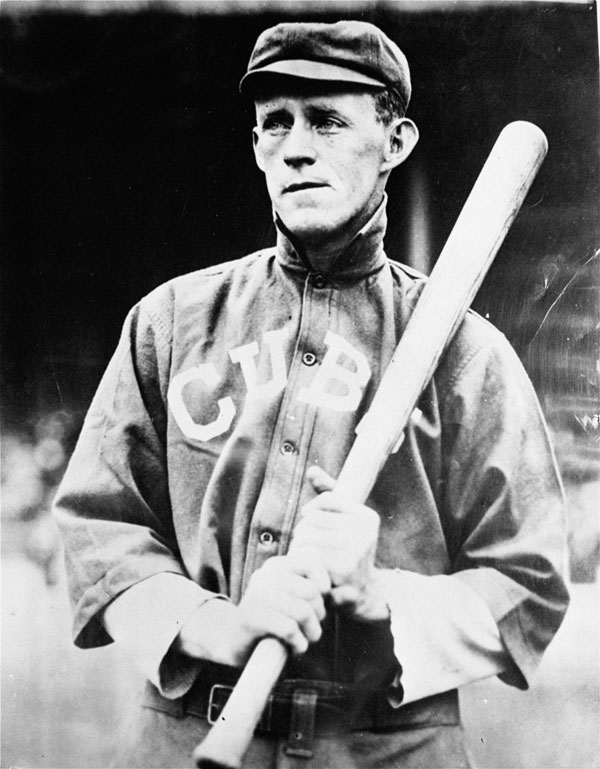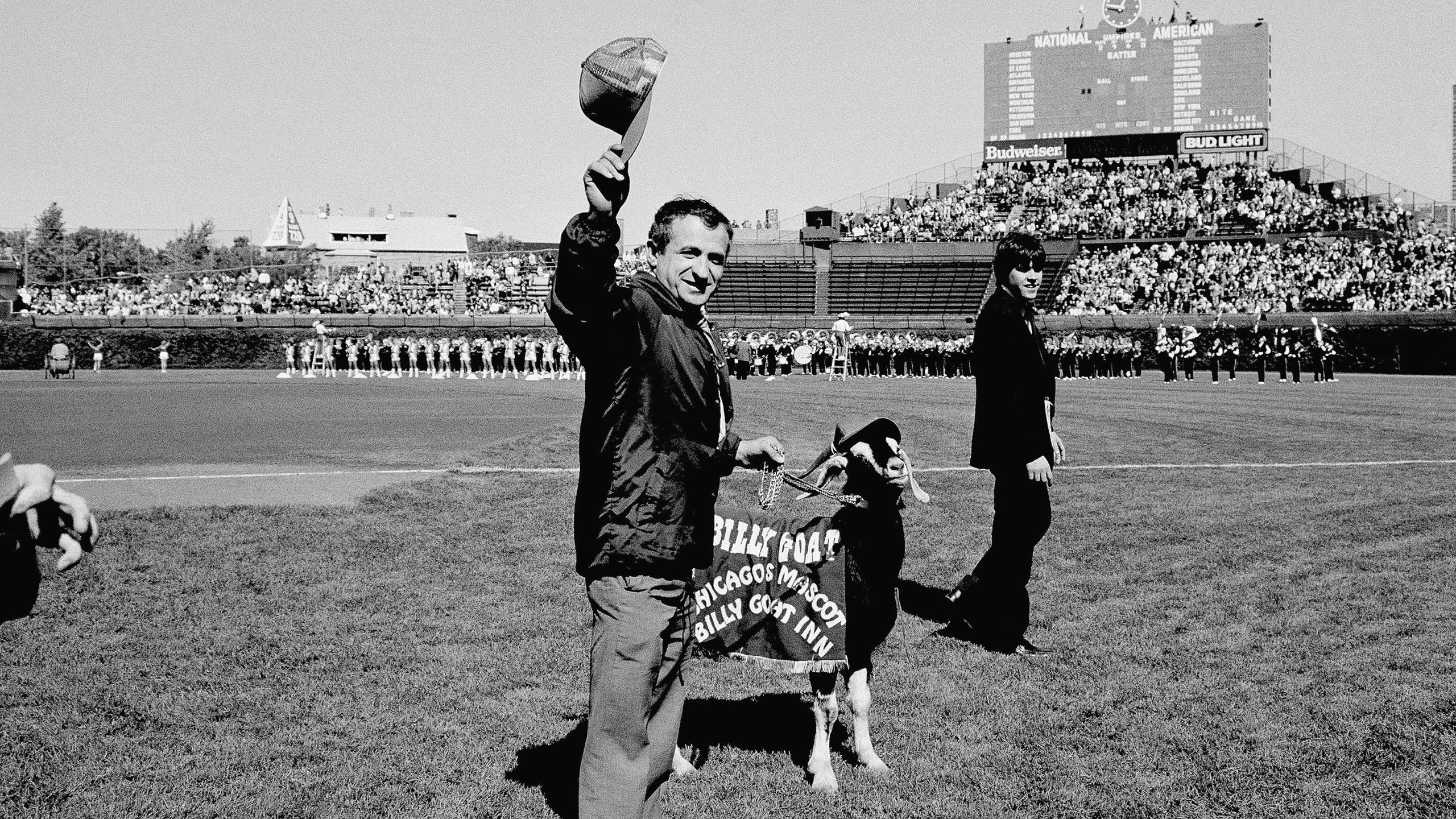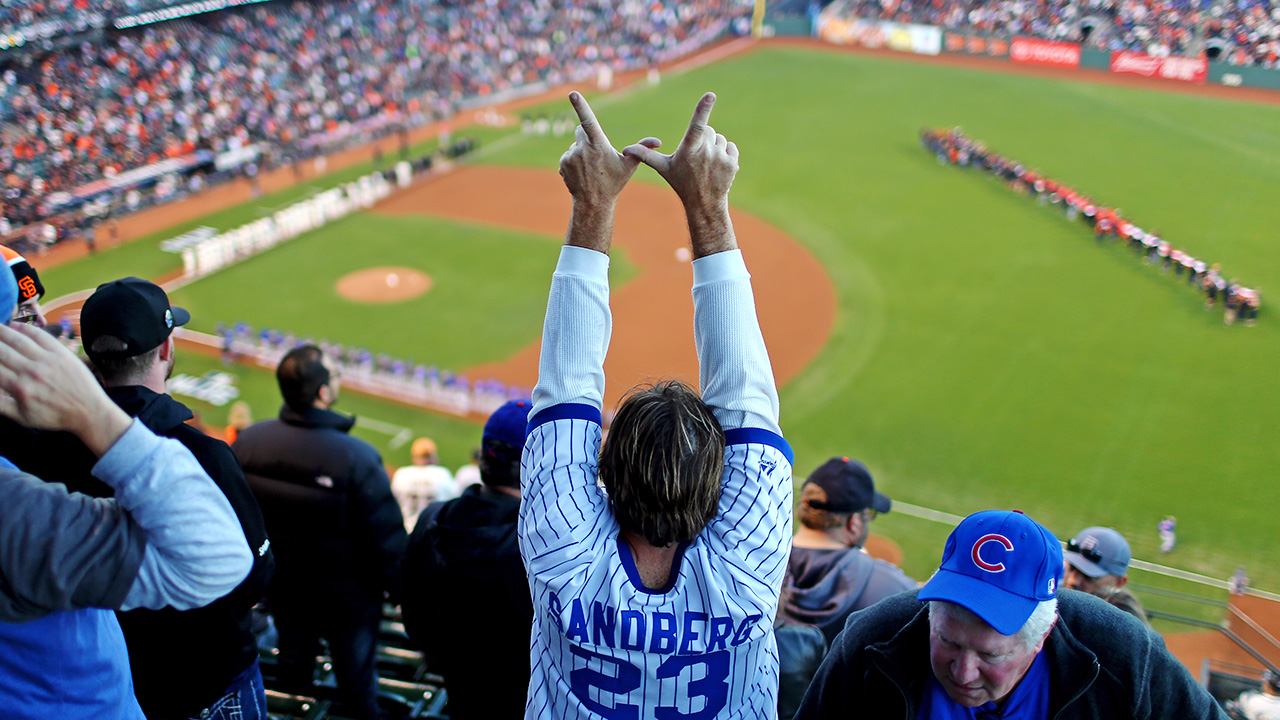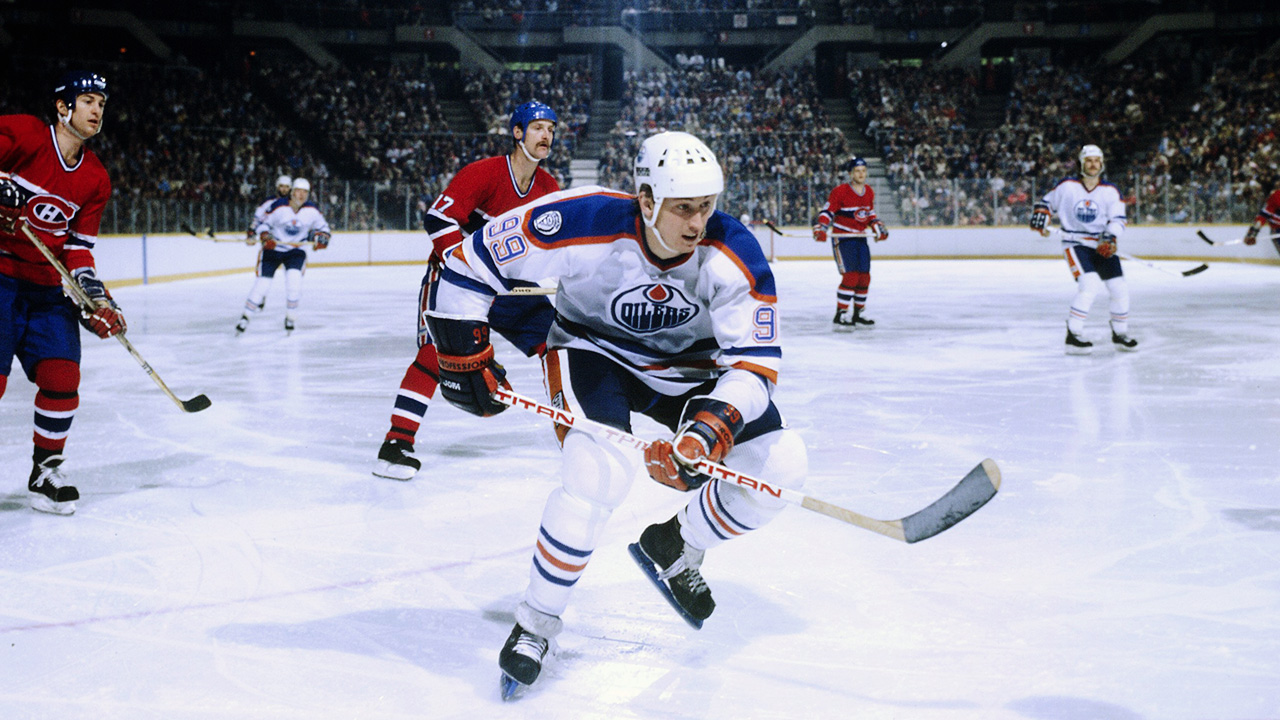Five hours before the Chicago Cubs played in the team’s first World Series game in 71 years, Ken Frandsen sat at the end of a bar watching Jeopardy on a rear-projection television hung in the corner of the L&L Tavern a few blocks south of Wrigley Field.
He’d been drinking there for a quarter of a century and has owned it for the last 18 years. Aside from the collection of Pabst Blue Ribbon signs he hung up after moving in, the bar is just as it was when he bought it—the grey tin ceiling, the creaky, uneven floor, the crooked bar top, and the giant wall vault that dates back to the 1930s, when he believes the establishment was owned by an associate of Al Capone. The jukebox boasts a wide array of Windy City bands at three songs for a quarter. The local drinking hole is an unchanging monument to decades of life in Chicago’s North Side.
Frandsen, in his late 50s, grew up a Cubs fan. He used to go to day games at Wrigley with his father, Louis, who saw the team lose the 1945 World Series to the Detroit Tigers. Frandsen lived vicariously through the stories his dad told of the glory days when his boys won five National League pennants in 16 seasons. But every time it looked like the Cubs would break through in Frandsen’s own lifetime, he always watched them falter. He can list the moments off—’69 stung, ’84 was brutal. “Talk about the sins of the father revisited on the son,” Frandsen says.

A few days earlier, as Chicago played the Los Angeles Dodgers for a spot in the World Series, every bar in the neighbourhood was packed and there was a line stretching down the block at the L&L Tavern. Inside, shoulder-to-shoulder, patrons watched the game on the two tiny old TVs above the bar. An hour-and-a-half before it was over they ran out of Bud Light and Old Style, a classic Midwestern brew. When the game ended, the fans flocked to the streets outside Wrigley Field to celebrate, but later bounced back to the L&L to keep the party going. It was one of the best nights for sales in the bar’s history. “When the Cubs win the World Series, people will die,” Frandsen says. “We have a bet, plus or minus two. Accidental shootings, whatever.”
Generations of Chicago Cubs fans have lived and died hoping their team would win a World Series title. And this may very well be the year that the Cubs’ 108-year championship drought comes to an end. They were the best team in baseball this season, with a 103-58 record. And as cranes rise on construction sites for swanky new restaurants, condos and hotels surrounding the Friendly Confines, there is an inescapable sense that this is the beginning of a new era in Wrigleyville. But the Cubs’ ethos is built on nostalgic fatalism.
The team’s misfortune can be traced back to a bizarre curse, at least one terrible trade, a series of devastating misplays in the field, and one ill-fated fan’s overeager attempt to snag a foul ball. In the shadows of Wrigley, you find cynics and believers. You find long-suffering fans in ancient taverns lamenting what should have been while carrying a hard-earned pride for enduring what wasn’t. It’s easy to love the winners; loving the losers requires something special. And among them all, you find regular people tied to the team’s misfortune, as much a part of the myth as the players, the bleachers, the scoreboard and the ivy climbing the outfield wall. On that cold October night that marked the start of the World Series, it didn’t matter much how it would end. The Cubs were there, finally—and that was all that mattered. It was everything; and everything was about to change.
At the corner of Clark and Addison a dozen tourists stood in silent awe, staring up at Wrigley Field’s famous red sign. Some took photos (one woman posed her dog, wearing a Chicago Cubs scarf), but each eventually returned to a state of inner contemplation as if registering a hallowed moment. It was still hours to game one of the World Series—which was being played 550 km away in Cleveland—but the faithful had come to worship at the gates of one of baseball’s oldest cathedrals.
The Cubs played their first game at Weeghman Park in 1916, eight years after they’d beaten the Detroit Tigers in the World Series for the second year in a row. Weeghman was renamed Cubs Park in 1920, and then Wrigley Field in 1926 when the team was purchased by chewing-gum magnate William Wrigley. They were winners back then—just not champions. After losing the 1910 World Series to the Philadelphia Athletics, the Cubs posted the second-best cumulative record in the majors over the next 35 years, earning six pennants but never hoisting the trophy.

Eleanor Olson lived through each of the Cubs’ World Series disappointments. She is as old as Wrigley itself. About to turn 103, Olson went to her first Cubs game with her father in 1926, when she was 14. “I don’t know if they won,” she says. “But I remember going.”
It was Ladies Day at Wrigley Field, and any woman over 16 got in free. Olson’s dad told the manager at Wrigley that a friend she brought with her was turning 16 in a month. She was only 14, but looked older than Olson. The manager agreed to give him back a dollar, the price of admission.
When Olson reached high school she and her friends made a tradition of attending on Ladies Day, taking the streetcar across town to Wrigley after their classes let out. “There was Hack Wilson, I liked him. Pat Malone was a good pitcher. And Cliff Heathcote, he was handsome,” Olson says, with a chuckle. “We’d go down to the front there—we didn’t get chased away—and we’d get autographs and we’d take snapshots. It was a different world then.”
She’s remained a Cubs fan ever since. And this year the team invited her to throw out the first pitch at a game. “It dribbled,” Olson says of her toss. “But it was fun. They treated me like a queen. I was wheelchaired back and forth forever.”

Olson watched the Cubs clinch this World Series appearance alone in her room at the suburban-Chicago retirement community she has lived in for the past three decades. “Oh, it felt real good. Not since ’45…,” Olson says, trailing off, remembering.
And if the Cubs win the Word Series? “That would be heavenly.”
But for Cubs fans to experience something so divine the team will have to shake what remains of a notorious curse that some fear has plagued them since Olson last saw them play for a championship. The legend goes like this: The Cubs were leading the 1945 World Series against the Detroit Tigers two games to one when a local bar owner, Billy Sianis, tried to bring his pet goat, Murphy, to game four at Wrigley for good luck. But ushers at the stadium told Sianis that that the goat was allowed into the stadium. Sianis angrily proclaimed that the Cubs would never win a World Series as long as the goat wasn’t allowed in Wrigley. Chicago lost that game, and then lost the series in seven.
At the original Billy Goat Tavern, perpetually shaded beneath the double-decked Michigan Ave. in downtown Chicago, Sam Sianis—Billy Sianis’ nephew—regularly retells the story that he’s built his business around. There is a goat head hung above the bar, and the walls are lined with articles about the curse and photos of celebrities who come through for one of the tavern’s famous cheeseburgers. (John Belushi used to be a regular and based his Olympia Restaurant skit from Saturday Night Live on his experience here.) Sianis came to Chicago from Greece when he was 17 years old, seven years after his uncle cursed the Cubs. But the 78-year-old is the official keeper of the legend, and he says the public has it right. “My uncle had two tickets. One for the goat and one for him,” he says. “They said, ‘You can come in, but no goats allowed in the ballpark.’ So my uncle said, ‘Goodbye, Cubs.’ And the Cubs lost.”

In the 1950s, despite the arrival of Ernie Banks, the Cubs spiraled into mediocrity and failed to make the playoffs in the decade. Then the goat curse appeared to hit the front office. In June 1964, the Cubs traded right-fielder Lou Brock to St. Louis for star pitcher Ernie Broglio as part of a six-player deal—and shortly after “Brock for Broglio” became well known as one of the worst trades in baseball history. Broglio went 4-7 with a 4.04 ERA the rest of the season and was out of baseball by 1967. Meanwhile, Brock hit .348 for the 1964 World Series–champion Cardinals. St. Louis won again in 1967 as Brock went on to a Hall of Fame career.
But the Cubs still had talent. With a core of future Hall of Famers like Banks, Ron Santo, Billy Williams and Ferguson Jenkins, Chicago showed promise in the late 1960s. In 1969 the Cubs led the NL East by nine games in mid-August when the team unraveled and talk of the curse rose again. The surging Mets had caught up to the Cubs when they met that September. During that game a black cat wandered onto the field in front of the Cubs bench. Chicago lost the game and wouldn’t reclaim first again that season.
A few years later, Sam Sianis offered to help reverse the curse. Chicago Tribune columnist Dave Condon arranged to have a new goat, a descendant of Murphy named Socrates, driven to the field in a limousine where it was greeted with a red carpet. The goat wore a sign that read: “All is forgiven. Let me lead the Cubs to the pennant.” But again, ushers wouldn’t let the goat in.
Predictably, to Sianis, the Cubs struggled through the rest of the 1970s and early ’80s. Then in 1984, Sianis was invited to bring his goat, a descendant of Murphy, to Wrigley Field on opening day. He walked around the field with the goat wearing a Cubs hat, while the fans cheered. Sianis lifted his hat and said, “The curse is lifted.”

That season the Cubs went 98-64 and made it to the NLCS against the San Diego Padres. They won the first two games at home in the best-of-five series, and Sianis offered to bring the goat to San Diego to ensure the victory—but he and the goat were left behind. The Padres won the next two games to tie up the series. In the deciding game, the Cubs led 3–2 in the seventh inning when a routine ground ball slipped through the legs of first baseman Leon Durham, allowing the tying run to score. The Padres went on to win 6–3. The curse continued.
Today, the goat has an outsized presence around Wrigley, where sidewalk vendors sell “I ain’t afraid of no goat” T-shirts. Actor Bill Murray, a lifelong Cubs fan who used to frequent Sianis’s bar with fellow Saturday Night Live cast member Belushi, wore a T-shirt emblazoned with a crossed-out goat to the first game of this season’s National League Division Series against the San Francisco Giants.
For all the grief the goat has caused Cubs fans, it’s made the Billy Goat Tavern famous. Sianis can fire off a long list of celebrities who have come through over the years, from Frank Sinatra to John Wayne. And Sianis still keeps goats on a friend’s farm in Indiana. He’s willing to step in to ward off a return of the curse if the Cubs run into trouble against Cleveland. “They look good. They look very good,” Sianis says. “But me and the goat, we’re going to help them win.”

While the curse is nonsense to many Cubs fans, there’s no denying the lingering effect it has on the collective psyche of the team’s supporters. It’s almost as though they expect the worse to happen. In 2003 the Cubs were again a game away from reaching the World Series, leading the Miami Marlins three games to two heading into game six at Wrigley Field. The Cubs were up 3–0 with one out in the eighth inning when it all came crashing down. The story is infamous now: On a foul ball down the left-field line, a fan attempted to catch a ball that Moises Alou had a bead on. Alou leapt into the stands to make the play, but the ball was deflected before he could reach it. The Cubs crumbled after that, inexplicably allowing eight runs in the inning on several mistakes in the field. The crowd turned on the fan who interfered with the ball, and when his name was revealed a day later, Steve Bartman—and his green turtleneck and headphones—entered baseball lore. He faced threats and constant harassment, and has never spoken publicly about the incident despite much interest from documentary crews and offers of large sums of money to appear in commercials.
Pat Looney thinks it’s all ridiculous. “I have to say he did nothing wrong,” Looney says while sitting at the Pony Tavern as the Cubs face Cleveland and Corey Kluber in game one. “I went for that ball five times more than he did.”
A lifelong Cubs fan, Looney sat a row in front of Bartman in that game, a few seats down. He lunged for the ball, too, and was just inches away from catching it. Bartman had been ushered away by security by the time the press descended on the section. But Looney, a local fireman who was 33 at the time, didn’t shy away—despite the fact that a couple of the friends he was with left immediately because they were worried about the crowd.

Because Looney spoke to reporters, his name got out before Bartman’s did. But he didn’t realize how bad it looked until he showed up at a friend’s bar and saw the replay. The friend dressed him in a sweater and hat to disguise him and sent him home. Later that night people found his number and filled his voicemail with angry messages. Two people showed up at his parents’ house and started jumping up and down on their cars. The next morning a photo of Looney reaching for the ball and Bartman making contact was everywhere.
Despite the attention, Looney went to game seven as planned. He was in line for a beer when TVs in the concourse started showing the already-well-worn replay. The broadcaster circled Looney, saying, “What about these other people?” and everyone in the concourse started chanting, “Asshole, asshole…,” at the screens. “Look, they didn’t know it was playable,” Looney told them, defending himself in the third person.
“Asshole, asshole…,” the crowd continued chanting. No one recognized him. He cut his losses and joined in the chant.
When the Cubs lost game seven, Looney knew it was going to get worse. He cancelled interviews and decided to stay quiet for a while. One of his closest friends wouldn’t talk to him for a month.
In the 13 years since the incident—he’s 47 now—Looney has become a forgotten footnote in the story. But still, someone has brought it up to him nearly every day. “I think that the whole Bartman thing became so big and so crazy just because of how he looked and how he acted,” Looney says. “If he came right out and said, ‘Hey, I’m sorry—it was 10 feet up in the air, I didn’t see [Alou] coming, I didn’t think it was playable,’ it wouldn’t have grown into this cartoonish figure that people piled on… They were ripping on a caricature.”
The anger towards Bartman has subsided over the years, despite his silence. Many fans acknowledge that Alex Gonzalez’s error at short a few plays later was more to blame for the loss, but it wasn’t played on repeat on national news stations. “Gonzalez should buy Bartman a new car every year,” Looney says. “That was worse than what [Bill] Buckner did. That was worse than Durham.”
As Looney watches Cleveland close out a 6–0 win over Chicago in game one, he says that the tone amongst Cubs fans has changed. Winning the NLCS over the Dodgers overcame a major hurdle. Their team was back in the World Series and there was a confidence in the air that Wrigleyville hadn’t seen in at least seven decades. “Not that people will be satisfied if they don’t win,” Looney says. “But unless they have a bunch of fluky loses, if they lose it’s because they played a hotter team. I think that [insecure] mentality is gone.”
The streets were empty when the bars in Chicago’s North Side closed after game one. A cold rain fell lightly in an October breeze. Cubs gear hung in the windows of the many souvenir shops that grow more frequent walking north on Clark. And on the corner of Clark and Addison stood the ghostly façade of Wrigley Field—almost black and white in the dark and the rain—like a postcard from the past, soon to arrive at someplace new.





